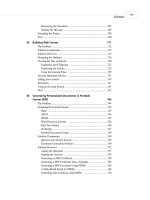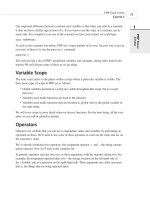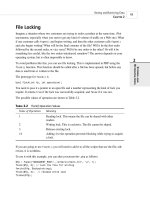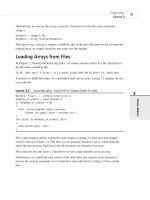Phát triển web với PHP và MySQL - p 16 doc
Bạn đang xem bản rút gọn của tài liệu. Xem và tải ngay bản đầy đủ của tài liệu tại đây (545.79 KB, 10 trang )
LISTING 5.3 header.inc—The Reusable Header for All TLA Web Pages
<html>
<head>
<title>TLA Consulting Pty Ltd</title>
<style>
h1 {color:white; font-size:24pt; text-align:center;
font-family:arial,sans-serif}
.menu {color:white; font-size:12pt; text-align:center;
font-family:arial,sans-serif; font-weight:bold}
td {background:black}
p {color:black; font-size:12pt; text-align:justify;
font-family:arial,sans-serif}
p.foot {color:white; font-size:9pt; text-align:center;
font-family:arial,sans-serif; font-weight:bold}
a:link,a:visited,a:active {color:white}
</style>
</head>
<body>
<! page header >
<table width=”100%” cellpadding = 12 cellspacing =0 border = 0>
<tr bgcolor = black>
<td align = left><img src = “logo.gif”></td>
<td>
<h1>TLA Consulting</h1>
</td>
<td align = right><img src = “logo.gif”></td>
</tr>
</table>
<! menu >
<table width = “100%” bgcolor = white cellpadding = 4 cellspacing = 4>
<tr >
<td width = “25%”>
<img src = “s-logo.gif”> <span class=menu>Home</span></td>
<td width = “25%”>
<img src = “s-logo.gif”> <span class=menu>Contact</span></td>
<td width = “25%”>
<img src = “s-logo.gif”> <span class=menu>Services</span></td>
<td width = “25%”>
<img src = “s-logo.gif”> <span class=menu>Site Map</span></td>
</tr>
</table>
Reusing Code and Writing Functions
C
HAPTER 5
5
REUSING CODE
AND
WRITING
FUNCTIONS
125
07 7842 CH05 3/6/01 3:35 PM Page 125
LISTING 5.4 footer.inc—The Reusable Footer for All TLA Web Pages
<! page footer >
<table width = “100%” bgcolor = black cellpadding = 12 border = 0>
<tr>
<td>
<p class=foot>© TLA Consulting Pty Ltd.</p>
<p class=foot>Please see our
<a href =”legal.php3”>legal information page</a></p>
</td>
</tr>
</table>
</body>
</html>
This approach gives you a consistent looking Web site very easily, and you can make a new
page in the same style by typing something like:
<? require(“header.inc”); ?>
Here is the content for this page
<? require(“footer.inc”); ?>
Most importantly, even after we have created many pages using this header and footer, it is
easy to change the header and footer files. Whether you are making a minor text change, or
completely redesigning the look of the site, you only need to make the change once. We do not
need to separately alter every page in the site because each page is loading in the header and
footer files.
The example shown here only uses plain HTML in the body, header and footer. This need not
be the case. Within these files, we could use PHP statements to dynamically generate parts of
the page.
Using auto_prepend_file and auto_append_file
If we want to use require() to add our header and footer to every page, there is another way
we can do it. Two of the configuration options in the php.ini file are auto_prepend_file and
auto_append_file. By setting these to our header and footer files, we ensure that they will be
loaded before and after every page.
For Windows, the settings will resemble the following:
auto_prepend_file = “c:/inetpub/include/header.inc”
auto_append_file = “c:/inetpub/include/footer.inc”
For UNIX, they will resemble the following:
auto_prepend_file = “/home/username/include/header.inc”
auto_append_file = “/home/username/include/footer.inc”
Using PHP
P
ART I
126
07 7842 CH05 3/6/01 3:35 PM Page 126
If we use these directives, we do not need to type require() statements, but the headers and
footers will no longer be optional on pages.
If you are using an Apache Web server, you can change various configuration options like
these for individual directories. To do this, your server must be set up to allow its main config-
uration file(s) to be overridden. To set up auto prepending and appending for a directory, create
a file called .htaccess in the directory. The file needs to contain the following two lines:
php_value auto_prepend_file “/home/username/include/header.inc”
php_value auto_append_file “/home/username/include/footer.inc”
Note that the syntax is slightly different from the same option in php.ini, as well as php_value
at the start of the line: There is no equal sign. A number of other php.ini configuration settings
can be altered in this way too.
This syntax changed from PHP 3. If you are using an old version, the lines in your .htaccess
file should resemble this:
php3_auto_prepend_file /home/username/include/header.inc
php3_auto_append_file /home/username/include/footer.inc
Setting options in the .htaccess file rather than in either php.ini or your Web server’s configu-
ration file gives you a lot of flexibility. You can alter settings on a shared machine that only
affect your directories. You do not need to restart the Web server, and you do not need adminis-
trator access. A drawback to the .htaccess method is that the files are read and parsed each
time a file in that directory is requested rather than just once at startup, so there is a perfor-
mance penalty.
Using include()
The statements require() and include() are very similar, but some important differences
exist in the way they work.
An include() statement is evaluated each time the statement is executed, and not evaluated at
all if the statement is not executed. A require() statement is executed the first time the state-
ment is parsed, regardless of whether the code block containing it will be executed.
Unless your server is very busy, this will make little difference but it does mean that code with
require() statements inside conditional statements is inefficient.
if($variable == true)
{
require(“file1.inc”);
}
else
{
require(“file2.inc”);
}
Reusing Code and Writing Functions
C
HAPTER 5
5
REUSING CODE
AND
WRITING
FUNCTIONS
127
07 7842 CH05 3/6/01 3:35 PM Page 127
This code will needlessly load both files every time the script is run, but only use one depend-
ing on the value of $variable. However, if the code had been written using two include()
statements, only one of the files would be loaded and used as in the following version:
if($variable == true)
{
include(“file1.inc”);
}
else
{
include(“file2.inc”);
}
Unlike files loaded via a require() statement, files loaded via an include() can return a
value. Therefore, we can notify other parts of the program about a success or failure in the
included file, or return an answer or result.
We might decide that we are opening files a lot and rather than retyping the same lines of code
every time, we want an include file to open them for us. Our include file might be called
“
openfile.inc” and resemble the following:
<?
@ $fp = fopen($name, $mode);
if (!$fp)
{
echo “<p><strong> Oh No! I could not open the file.</strong></p>”;
return 0;
}
else
{
return 1;
}
?>
This file will try to open the file named $name using the mode given by $mode. If it fails, it will
give an error message and return 0. If it succeeds, it will return 1 and generate no output.
We can call this file in a script as follows:
$name = “file.txt”;
$mode = “r”;
$result = include(“openfile.php”);
if( $result == 1 )
{
// do what we wanted to do with the file
// refer to $fp created in the include file
}
Using PHP
P
ART I
128
07 7842 CH05 3/6/01 3:35 PM Page 128
Note that we can create variables in the main file or in the included or required file, and the
variable will exist in both. This behavior is the same for both require() and include() state-
ments.
You cannot use require() in exactly the way shown here because you cannot return values
from require() statements. Returning a value can be useful because it enables you to notify
later parts of your program about a failure, or to do some self-contained processing and return
an answer. Functions are an even better vehicle than included files for breaking code into self-
contained modules. We will look at functions next.
If you are wondering why, given the advantages of include() over require(), you would ever
use require(), the answer is that it is slightly faster.
Using Functions in PHP
Functions exist in most programming languages. They are used to separate code that performs
a single, well-defined task. This makes the code easier to read and allows us to reuse the code
each time we need to do the same task.
A function is a self-contained module of code that prescribes a calling interface, performs
some task, and optionally returns a result.
You have seen a number of functions already. In preceding chapters, we have routinely called a
number of the functions that come built-in to PHP. We have also written a few simple functions
but glossed over the details. In this section, we will cover calling and writing functions in more
detail.
Calling Functions
The following line is the simplest possible call to a function:
function_name();
This calls a function named function_name that does not require parameters. This line of code
ignores any value that might be returned by this function.
A number of functions are called in exactly this way. The function phpinfo() is often useful in
testing because it displays the installed version of PHP, information about PHP, the Web server
set-up, and the values of various PHP and server variables. This function does not take any
parameters, and we generally ignore its return value, so a call to phpinfo() will resemble the
following:
phpinfo();
Reusing Code and Writing Functions
C
HAPTER 5
5
REUSING CODE
AND
WRITING
FUNCTIONS
129
07 7842 CH05 3/6/01 3:35 PM Page 129
Most functions do require one or more parameters—information given to a function when it is
called that influences the outcome of executing the function. We pass parameters by placing
the data or the name of a variable holding the data inside parentheses after the function name.
A call to a function with a parameter resembles the following:
function_name(“parameter”);
In this case, the parameter we used was a string containing only the word parameter, but the
following calls are also fine depending on the function:
function_name(2);
function_name(7.993);
function_name($variable);
In the last line, $variable might be any type of PHP variable, including an array.
A parameter can be any type of data, but particular functions will usually require particular
data types.
You can see how many parameters a function takes, what each represents, and what data type
each needs to be from the function’s prototype. We often show the prototype when we describe
a function, but you can find a complete set of function prototypes for the PHP function library
at .
This is the prototype for the function fopen():
int fopen( string filename, string mode, [int use_include_path] );
The prototype tells us a number of things, and it is important that you know how to correctly
interpret these specifications. In this case, the word int before the function name tells us that
this function will return an integer. The function parameters are inside the parentheses. In the
case of fopen(), three parameters are shown in the prototype. The parameter filename and
mode are strings and the parameter is an integer.
The square brackets around use_include_path indicate that this parameter is optional. We can
provide values for optional parameters or we can choose to ignore them, and the default value
will be used.
After reading the prototype for this function, we know that the following code fragment will be
a valid call to fopen():
$name = “myfile.txt”;
$openmode = “r”;
$fp = fopen($name, $openmode)
This code calls the function named fopen(). The value returned by the function will be stored
in the variable $fp. We chose to pass to the function a variable called $name containing a string
Using PHP
P
ART I
130
07 7842 CH05 3/6/01 3:35 PM Page 130
representing the file we want to open, and a variable called $openmode containing a string rep-
resenting the mode in which we want to open the file. We chose not to provide the optional
third parameter.
Call to Undefined Function
If you attempt to call a function that does not exist, you will get an error message as shown in
Figure 5.3.
Reusing Code and Writing Functions
C
HAPTER 5
5
REUSING CODE
AND
WRITING
FUNCTIONS
131
FIGURE 5.3
This error message is the result of calling a function that does not exist.
The error messages that PHP gives are usually very useful. This one tells us exactly in which
file the error occurred, in which line of the script it occurred, and the name of the function we
attempted to call. This should make it fairly easy to find and correct.
There are two things to check if you see this error message:
1. Is the function name spelled correctly?
2. Does the function exist in the version of PHP you are using?
It is not always easy to remember how a function name is spelled. For instance, some two-
word function names have an underscore between the words and some do not. The function
stripslashes() runs the two words together, whereas the function strip_tags() separates
the words with an underscore. Misspelling the name of a function in a function call results in
an error as shown in Figure 5.3.
Many functions used in this book do not exist in PHP 3.0 because this book assumes that you
are using at least PHP 4.0. In each new version, new functions are defined and if you are using
an older version, the added functionality and performance justify an upgrade. To see when a
particular function was added, you can see the online manual at www.php.net. Attempting to
call a function that is not declared in the version you are running will result in an error such as
the one shown in Figure 5.3.
07 7842 CH05 3/6/01 3:35 PM Page 131
Case and Function Names
Note that calls to functions are not case sensitive, so calling function_name(),
Function_Name(), or FUNCTION_NAME() are all valid and will all have the same result. You are
free to capitalize in any way you find easy to read, but you should aim to be consistent. The
convention used in this book, and most other PHP documentation, is to use all lowercase.
It is important to note that function names behave differently to variable names. Variable
names are case sensitive, so $Name and $name are two separate variables, but Name() and
name() are the same function.
In the preceding chapters, you have seen many examples using some of PHP’s built-in func-
tions. However, the real power of a programming language comes from being able to create
your own functions.
Why Should You Define Your Own Functions?
The functions built in to PHP enable you to interact with files, use a database, create graphics,
and connect to other servers. However, in your career there will be many times when you will
need to do something that the language’s creators did not foresee.
Fortunately, you are not limited to using the built-in functions because you can write your own
to perform any task that you like. Your code will probably be a mixture of existing functions
combined with your own logic to perform a task for you. If you are writing a block of code for
a task that you are likely to want to reuse in a number of places in a script or in a number of
scripts, you would be wise to declare that block as a function.
Declaring a function allows you to use your own code in the same way as the built-in func-
tions. You simply call your function and provide it with the necessary parameters. This means
that you can call and reuse the same function many times throughout your script.
Basic Function Structure
A function declaration creates or declares a new function. The declaration begins with the key-
word function, provides the function name, the parameters required, and contains the code
that will be executed each time this function is called.
Here is the declaration of a trivial function:
function my_function()
{
echo “My function was called”;
}
Using PHP
P
ART I
132
07 7842 CH05 3/6/01 3:35 PM Page 132
This function declaration begins with function, so that human readers and the PHP parser
know that what follows will be a user-defined function. The function name is my_function.
We can call our new function with the following statement:
my_function();
As you probably guessed, calling this function will result in the text “My function was
called.” appearing in the viewer’s browser.
Built-in functions are available to all PHP scripts, but if you declare your own functions, they
are only available to the script(s) in which they were declared. It is a good idea to have one file
containing your commonly used functions. You can then have a
require() statement in all
your scripts to make your functions available.
Within a function, curly braces enclose the code that performs the task you require. Between
these braces, you can have anything that is legal elsewhere in a PHP script including function
calls, declarations of new variables or functions,
require() or include() statements, and
plain HTML. If we want to exit PHP within a function and type plain HTML, we do it the
same way as anywhere else in the script—with a closing PHP tag followed by the HTML. The
following is a legal modification of the previous example and produces the same output:
<?
function my_function()
{
?>
My function was called
<?
}
?>
Note that the PHP code is enclosed within matching opening and closing PHP tags. For most
of the small code fragment examples in this book, we do not show these tags. They are shown
here because they are required within the example as well as above and below it.
Naming Your Function
The most important thing to consider when naming your functions is that the name should be
short but descriptive. If your function creates a page header, pageheader() or page_header()
might be good names.
A few restrictions are as follows:
• Your function cannot have the same name as an existing function.
• Your function name can only contain letters, digits, and underscores.
• Your function name cannot begin with a digit.
Reusing Code and Writing Functions
C
HAPTER 5
5
REUSING CODE
AND
WRITING
FUNCTIONS
133
07 7842 CH05 3/6/01 3:35 PM Page 133
Many languages do allow you to reuse function names. This feature is called function over-
loading. However, PHP does not support function overloading, so your function cannot have
the same name as any built-in function or an existing user-defined function. Note that although
every PHP script knows about all the built-in functions, user-defined functions only exist in
scripts where they are declared. This means that you could reuse a function name in a different
file, but this would lead to confusion and should be avoided.
The following function names are legal:
name()
name2()
name_three()
_namefour()
These are illegal:
5name()
name-six()
fopen()
(The last would be legal if it didn’t already exist.)
Parameters
In order to do their work, most functions require one or more parameters. A parameter allows
you to pass data into a function. Here is an example of a function that requires a parameter.
This function takes a one-dimensional array and displays it as a table.
function create_table($data)
{
echo “<table border = 1>”;
reset($data); // Remember this is used to point to the beginning
$value = current($data);
while ($value)
{
echo “<tr><td>$value</td></tr>\n”;
$value = next($data);
}
echo “</table>”;
}
If we call our create_table() function as follows:
$my_array = array(“Line one.”,”Line two.”,”Line three.”);
create_table($my_array);
we will see output as shown in Figure 5.4.
Using PHP
P
ART I
134
07 7842 CH05 3/6/01 3:35 PM Page 134









